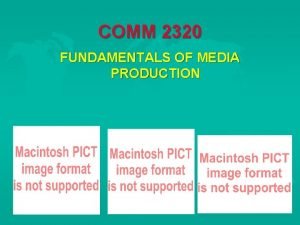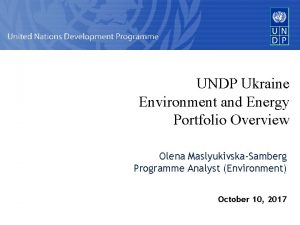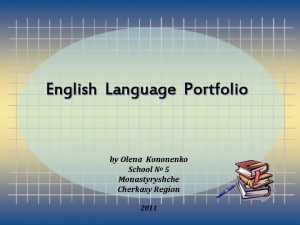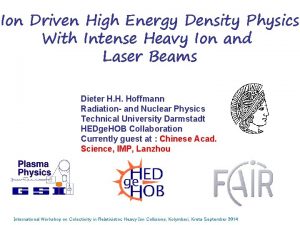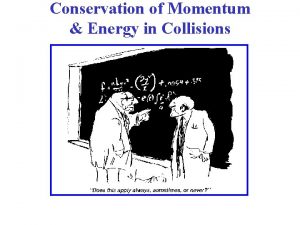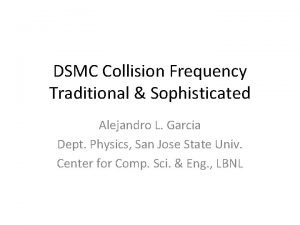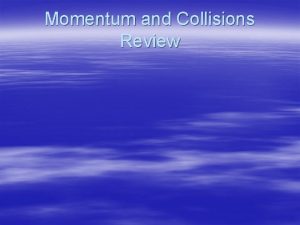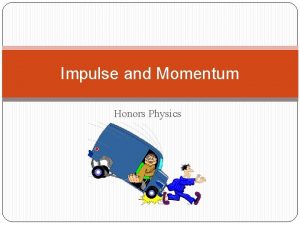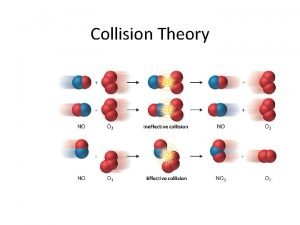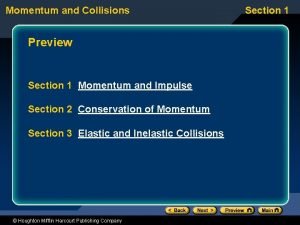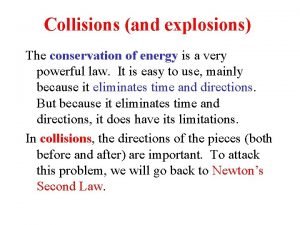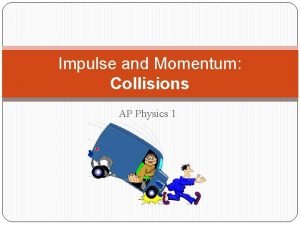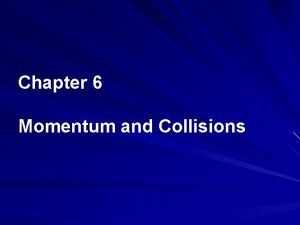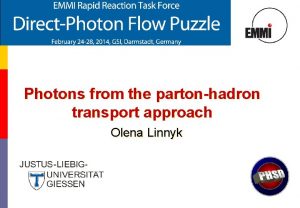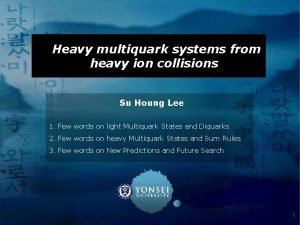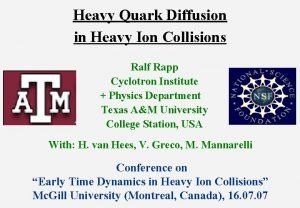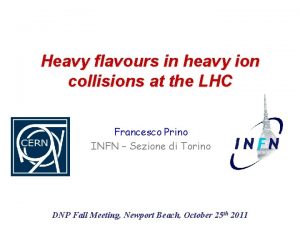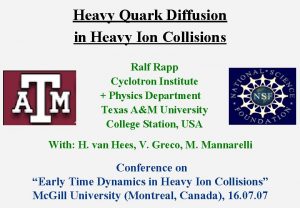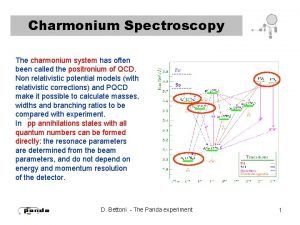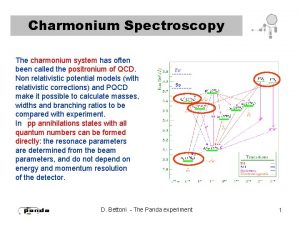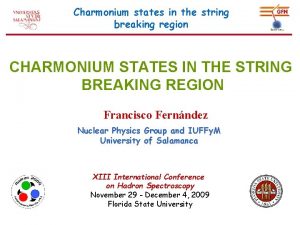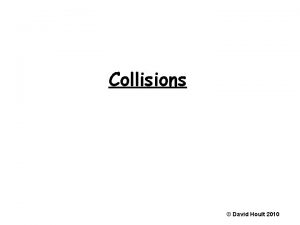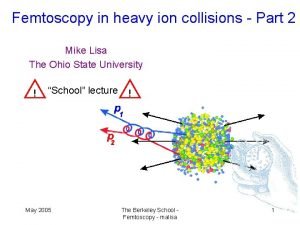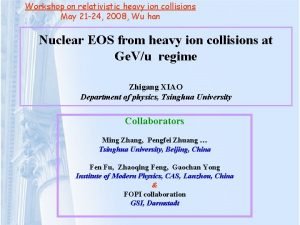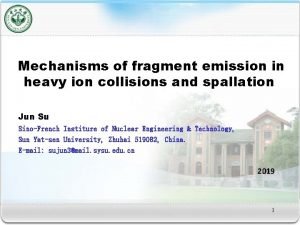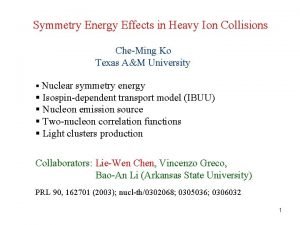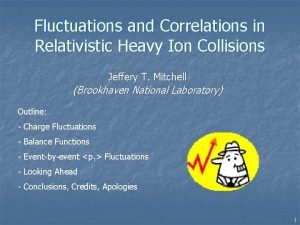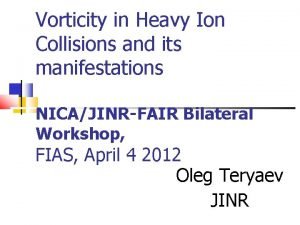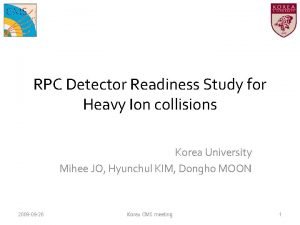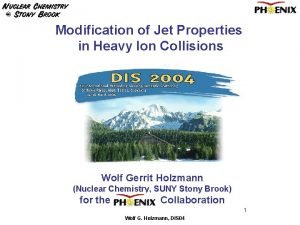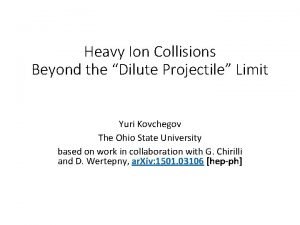Charmonium in heavy ion collisions Olena Linnyk 16





















- Slides: 21

Charmonium in heavy ion collisions Olena Linnyk 16 July 2007


Anomalous J/Y suppression Charm sector reflects the dynamics in the early phase of heavy-ion collisions ! J/Y ‚normal‘ absorption by nucleons (Glauber model) Experimental observation (NA 38/50/60): extra suppression in A+A collisions; increasing with centrality

Scenarios for anomalous charmonium suppression • Comover absorption • QGP colour screening [Digal, Fortunato, Satz ’ 03] Quarkonium dissociation T: Dissociation energy density ed ~ 2(Td/Tc)4 c. C melting J/Y [Gavin & Vogt, Capella et al. `97] absorption by low energy inelastic scattering with ‚comoving‘ mesons (m=p, h, r, . . . ) J/Y+m <-> D+Dbar Y´ +m <-> D+Dbar c. C +m <-> D+Dbar

Check the scenarios using transport models Initial State D J/Y Hadronization time Y‘ c. C Dbar Freeze-out Quark-Gluon-Plasma ? Transport models Microscopical transport models provide the dynamical description of nonequilibrium effects in heavy-ion collisions HSD – Hadron-String-Dynamics transport approach

Charmonium production in p. N Hard probe -> binary scaling! s. J/Yexp = s. J/Y + B(cc->J/Y) scc + B(Y´->J/Y) s. Y´

Modelling the comover scenario in HSD 1. Charmonia dissociation cross sections with p, r, K and K* mesons J/Y (cc, Y‘) + meson (p, r, K , K*) <-> D+Dbar • Phase-space model for charmonium + meson dissociation: constant matrix element 2. J/Y recombination cross sections by D+Dbar annihilation: D+Dbar -> J/Y (cc, Y‘) + meson (p, r, K , K*) are determined by detailed balance! [PRC 67 (2003) 054903]

Modeling the QGP melting in HSD Energy density e (x=0, y=0, z; t) from HSD Threshold energy densities: J/Y melting: e(J/Y )=16 Ge. V/fm 3 cc melting: e(cc ) =2 Ge. V/fm 3 ‚ ‚ Y melting: e(Y ) =2 Ge. V/fm 3 [Olena Linnyk et al. , nucl-th/0612049, NPA 786 (2007) 183 ]

Charmonium recombination by DDbar annihilation At SPS recreation of J/Y by D-Dbar annihilation is negligible NDD~16 But at RHIC recreation of J/Y by D-Dbar annihilation is strong!

Comparison to data

Pb+Pb and In+In @ 158 A Ge. V comover absorption Pb+Pb and In+In @ 160 A Ge. V consistent with the comover absorption for the same parameter set! [OL et al NPA 786 (2007) 183]

Pb+Pb and In+In @ 158 A Ge. V QGP threshold melting Y´ absorption too strong, which contradict data [OL et al NPA 786 (2007) 183] ‚ e(J/Y )=16 Ge. V/fm 3, e(cc ) =e(Y ) =2 Ge. V/fm 3

Au+Au @ s 1/2=200 Ge. V Comover absorption Energy density cut ecut=1 Ge. V/fm 3 reduces the meson comover absorption || Space for partonic effects In the comover scenario the J/Y suppression at midrapidity is stronger than at forward rapidity, unlike the data! [OL et al ar. Xiv: 0705. 4443]

Au+Au @ s 1/2=200 Ge. V Threshold melting Charmonia recombination is important! Energy density cut ecut=1 Ge. V/fm 3 reduces the meson comover absorption, however, D+Dbar Satz’s model: complete dissociation of annihilation can not generate initial J/Y and Y ´ due to the very large QGP threshold melting scenario is ruled out by PHENIX data!enough charmonia, especially for peripheral collisions! local energy densities !

J/Y excitation function Comover reactions in the hadronic phase give almost a constant suppression; pre-hadronic reactions lead to a larger recreation of charmonia with Ebeam. The J/Y melting scenario with hadronic comover recreation shows a maximum suppression at Ebeam = 1 A Te. V; exp. data ?

Y´ excitation function Y´ suppression provides independent information on absorption vs. recreation mechanisms !

p J/Y probes early stages of fireball and HSD is the tool to model it. p Comover absorption and threshold melting both reproduce J/Y survival in Pb+Pb as well as in In+In @ 158 A Ge. V, while Y´ data are in conflict with the melting scenario. p Comover absorption and colour screening fail to describe Au+Au at s 1/2=200 Ge. V at mid- and forward rapidities simultaneously. p Deconfined phase is clearly reached at RHIC, but a theory having the relevant/proper degrees of freedom in this regime is needed to study its properties ( PHSD). PHSD - transport description of the partonic and hadronic phases

ar. Xiv: 0705. 4443 nucl-th/0612049 ar. Xiv: 0704. 1410

Back-up slide 1 local energy densityvs Bjorken energy density • transient time for central Au+Au at 200 Ge. V: Y t ~ 2 R /g ~ 0. 13 fm/c J/Y • cc formation time: t ~ 1/M ~ 1/4 Ge. V ~ 0. 05 fm/c < t c • cc pairs are produced in the initial NN collisions in time period t ‚ r c C A cm T r r Bjorken energy density: AT is the nuclei transverse overlap area t is the formation time of the medium at RHIC e. Bj t ~ 5 Ge. V/fm 2/c ‚Local‘ energy density e during transient time tr : e ~ 5[Ge. V/fm 2/c] / [0. 13 fm/c] ~ 30 Ge. V/fm 3 accounting t. C : e~ 28 Ge. V/fm 3 ü HSD reproduces PHENIX data for Bjorken energy density very well ü HSD results are consistent with simple estimates for the energy density

Back-up slide 2 PHSD Initial A+A collisions – HSD: string formation and decay to pre-hadrons Fragmentation of pre-hadrons into quarks: using the quark spectral functions from the Dynamical Quasi. Particle Model (DQPM) ( approximation to QCD DQPM: Peshier, Cassing, PRL 94 (2005) 172301; Cassing, ar. Xiv: 0704. 1410[nucl-th], NPA‘ 07 Partonic phase: quarks and gluons (= ‚dynamical quasiparticles‘) with offshell spectral functions (width, mass) defined by DQPM elastic and inelastic parton-parton interactions: using the effective cross sections from the DQPM ü q + qbar (flavor neutral) <=> gluon (colored) ü gluon + gluon <=> gluon (possible due to large spectral width) ü q + qbar (color neutral) <=> hadron resonances Hadronization: based on DQPM - massive, off-shell quarks and gluons with broad spectral functions hadronize to off-shell mesons and baryons: gluons q + qbar; q + qbar meson; q +q baryon Hadronic phase: hadron-string interactions – off-shell HSD

Basic concepts of Hadron-String Dynamics • for each particle species i (i = N, R, Y, p, r, K, …) the phase-space density f follows the transport equations q q q i with the collision terms Icoll describing: elastic and inelastic hadronic reactions BB <-> B´B´, BB <-> B´B´m, m. B <-> m´B´, m. B <-> B´ formation and decay of baryonic and mesonic resonances string formation and decay (for inclusive production: BB->X, m. B->X, X =many particles) • Implementation of detailed balance on the level of 1<->2 and 2<->2 reactions (+ 2<->n multi-meson fusion reactions) • Off-shell dynamics for short living states
 Minecraft charmonium
Minecraft charmonium Olena maslyukivska
Olena maslyukivska Olena kononenko
Olena kononenko Ratey rational functions
Ratey rational functions Heavy ion
Heavy ion Fuerzas dipolo-dipolo ejemplos
Fuerzas dipolo-dipolo ejemplos What is london forces
What is london forces C6h12 fuerza intermolecular
C6h12 fuerza intermolecular Qumica
Qumica Perfectly elastic collision
Perfectly elastic collision What is collision frequency
What is collision frequency Momentum and collisions review
Momentum and collisions review Impulse and momentum relationship
Impulse and momentum relationship Is momentum conserved in all collisions
Is momentum conserved in all collisions Collision theory diagrams
Collision theory diagrams To avoid collisions a defensive driver should
To avoid collisions a defensive driver should Collisions
Collisions Collisions and explosions
Collisions and explosions Ap physics collisions
Ap physics collisions What are five reasons expressways have fewer collisions
What are five reasons expressways have fewer collisions Type of momentum
Type of momentum Prévention des collisions engins-piétons
Prévention des collisions engins-piétons
